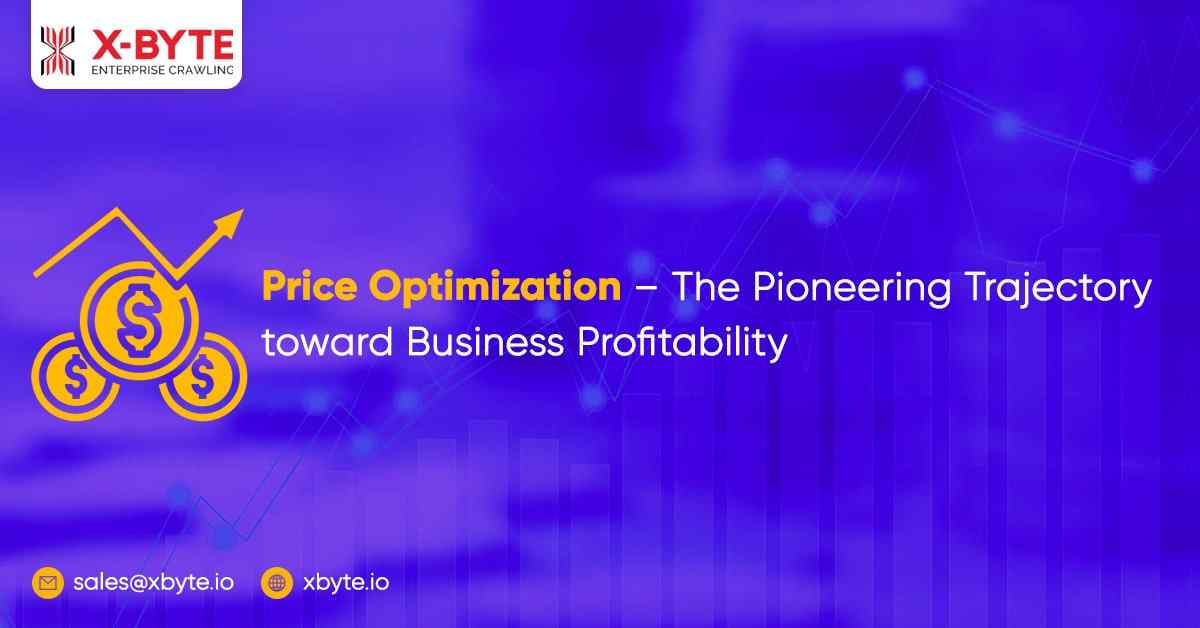
Proper pricing can make or break a business. If you emulate your competitors’ prices, a price war may begin. If you make a blind guess, your business’s sales could plunge into an abyss. Getting out will be nearly impossible. It is in such a tenuous context that price optimization comes into the picture. Understanding what your target clientele is willing to do is helpful. You can splurge on your products. It can vehemently bolster your sales, customer satisfaction, and overall business growth. A successful competitor price monitoring entails finding the sweet spot. You can find the value and the lucrative spot. Gaining that balance is easier said than done. Our guide is carefully curated to help you navigate the process.
Price Optimization Explained

Price optimization can be defined as analyzing customer and market data. It will help to arrive at the most optimal price point for a product or service your enterprise offers. Price optimization aims to determine the best price at the fulcrum of value and profit. It will bolster customer acquisition, maximize sales and accelerate profits. The typical information used in price optimization includes:
• Customer survey data
• Inventories
• Historical sales data
• Demographic and psychographic data
• Machine learning outputs
• Geographical market specifics
• Demand fluctuations
• Competitive advantages and concerns
• Lifetime value
• Churn data and more
Examples of Price Optimization:

The two best examples of price optimization are airfares and event tickets.
• Airfare – Airlines use price elasticity to keep up with competitors’ fares. They aggregate the pricing of flights by their competitors in real-time. It is why the rates of plane tickers increase and decrease simultaneously.
• Event Tickets – The second best example of stellar price optimization is event tickets. Tickeeters use algorithms for dynamic pricing. This means the higher the demand for an event, the greater the price.
Three Things You Need for Price Optimization:

There are three things you should prioritize in price optimization. You should also prioritize competitor price monitoring this way –
• Starting prices: The base price helps your customers. They can know if your product or service is worth their time and investment. The starting price must be optimized. It is to be compatible with the baseline demand for your product. Optimizing starting prices is essential for businesses. It is whose products remain stable over time, like SaaS solutions, groceries, etc.
• Discounted Prices: It is a tried-and-tested trajectory to acquire new customers.
• Promotional Prices: Sales of both new products and promotional bundles can benefit. It is from optimally priced promotions. If a software as a service (SaaS) company were to introduce a new remote work solution.
Five Ways to Optimize Price: A Crisp Overview

Understanding the optimal price of a product or service begins this way. It starts with gauging your target customers’ needs, desires, and aspirations. Likewise, it is also essential to grasp your market and industry trends and patterns. For example, the pricing for B2B is vastly different from B2C. At first glance, dabbling into price optimization may seem daunting and delightful. However, the five simple steps below can help.
1. Dig the Data:
The first step in price optimization is to remember that it is not a guessing game. You need complex data to maneuver the process. Thus, qualitative and quantitative data are the bedrock. It helps to determine how much your customers are willing and able to pay for your products or services. Examples of quantitative data include information about inventory. It can include historical markets, sales data, churn rate, price sensitivity, and more. Likewise, qualitative data provides information subjective information extracted from customer surveys.
2. Defining Goals and Hurdles
Most enterprises aiming at price optimization have a profit-oriented approach. However, it is critical to remember that profit accruing is one of the many milestones. This can be achieved by finding the perfect price. Upselling, customer loyalty, retention, and acquisition are achievable goals. It is with sound price optimization and competitor price monitoring. Your aim might be to increase the product’s perceived value or hit a specific sales quote. Whatever the finish line looks like, the key is to remain precise.
3. Know Your Value Metric
The third step in robust price optimization is the right value metric. It determines what and how you charge for your product and service. It helps fix the prices at a range that aligns with the value people derive from your products or services. If you sell software, you might levy costs for specific features, hours of hosting, etc.
The way to gauge the value metric is to learn what customers value. It is about your product and experimenting with ways to charge for that value.
4. Create Price Tiers
After gathering client data and value metrics, set your company’s pricing tiers. Each tier should match a client category you discovered and the value metric. Adobe divides consumers into four categories. They are individuals, businesses, students and teachers, schools, and universities. It is to adjust the price for each program.
5. Continuous Price Monitoring
Finally, price optimization is dynamic and requires ongoing monitoring and updates. Every year or two, adjust your price approach as you add new features. You can diversify production and win new clients. Price variations upset customers and drive them to your competition. So, keep pricing stable immediately.
Models of Pricing Strategies

One price optimization methodology focuses on your company’s pricing strategy. It is while the other uses figures and big data. Setting the best price is price optimization. Some of the common pricing strategy models include –
• Captive product pricing
• Competitor price monitoringFreemium pricing
• Hourly pricing
• Price skimming
• Dynamic pricing and more
The second type of price optimization model is math-based. It centers on data on demand, customer behavior, price levels, inventory, costs, and more. Artificial machines, machine learning, and human faculty are used for math-based price optimization.
Conclusion
So, here is a crisp overview of price optimization. A robust competitor price monitoring can help maximize your business’s sales. It helps boost profits and reputation.
